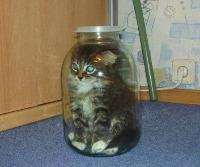flipflop
- UAVpilot
-
 Topic Author
Topic Author
- Offline
- New Member
-

- Posts: 12
- Thank you received: 0
Who can explain why the I/O type is used for the "out" pin?
component flipflop "D type flip-flop";
pin in bit data_ "data input";
pin in bit clk "clock, rising edge writes data to out";
pin in bit set "when true, force out true";
pin in bit reset "when true, force out false; overrides set";
pin io bit out "output";
Please Log in or Create an account to join the conversation.
- tommylight
-

- Away
- Moderator
-

- Posts: 21019
- Thank you received: 7163
Please Log in or Create an account to join the conversation.
- PCW
-

- Away
- Moderator
-

- Posts: 17462
- Thank you received: 5101
that is:
setp flipflop.0.out true
does set the output true
and
setp flipflop.0.out false
does set the output false
Please Log in or Create an account to join the conversation.
- UAVpilot
-
 Topic Author
Topic Author
- Offline
- New Member
-

- Posts: 12
- Thank you received: 0
net signame flipflop.0.out => carousel.0.enablesigname signal was TRUE. I could not change this in any way manipulations with flipflop inputs.
Perhaps the reason is that the carousel component was at that time in incomprehensible state. Unfortunately I can not reproduce this effect yet...
Perhaps this situation arose because of the failure of the carousel component. Or maybe it was the cause of the carousel's failure...
Please Log in or Create an account to join the conversation.
- PCW
-

- Away
- Moderator
-

- Posts: 17462
- Thank you received: 5101
since the flipflop output is a I/O pin, this would be legal if the connected pin was also an
I/O pin ( for example 2 flip flop outputs connected in parallel might stick like this)
carousel.0.enable is an input so should not be able to affect the state of the flipflop output
Please Log in or Create an account to join the conversation.
- UAVpilot
-
 Topic Author
Topic Author
- Offline
- New Member
-

- Posts: 12
- Thank you received: 0
No.Do you have another output driving signame?
All the connections with this signal I observed in halshow - there were no others.since the flipflop output is a I/O pin, this would be legal if the connected pin was also an
I/O pin ( for example 2 flip flop outputs connected in parallel might stick like this)
carousel.0.enable is an input so should not be able to affect the state of the flipflop output
I believe that this is the fault of the incomprehensible state of LinuxCNC, which happened after the next command to change the tool "M6T2" - the carousel component was in a strange state and did not give the command to turn on the motor, despite the state of the input signals.
But the essence of my question is not in this problem.
So far I'm inclined to think that the "io" type was specified by chance, instead of "out."
Please Log in or Create an account to join the conversation.
- PCW
-

- Away
- Moderator
-

- Posts: 17462
- Thank you received: 5101
in my experience the HMI and interpreter can pretty much take a hike and the hal stuff still keeps ticking
If you have the dev tools installed, it would be trivial to recompile flipflop with its output pin changed
to an simple output as a test
Please Log in or Create an account to join the conversation.
- UAVpilot
-
 Topic Author
Topic Author
- Offline
- New Member
-

- Posts: 12
- Thank you received: 0
After restarting LinuxCNC, this problem can not be repeated.
Continues these experiments there is no possibility - the machine is in production. I changed the HAL file by completely eliminating this trigger.
It is not possible to reproduce such a situation on the test bench.
Please Log in or Create an account to join the conversation.
- PCW
-

- Away
- Moderator
-

- Posts: 17462
- Thank you received: 5101
or the thread failing
Please Log in or Create an account to join the conversation.
- UAVpilot
-
 Topic Author
Topic Author
- Offline
- New Member
-

- Posts: 12
- Thank you received: 0
Please Log in or Create an account to join the conversation.
